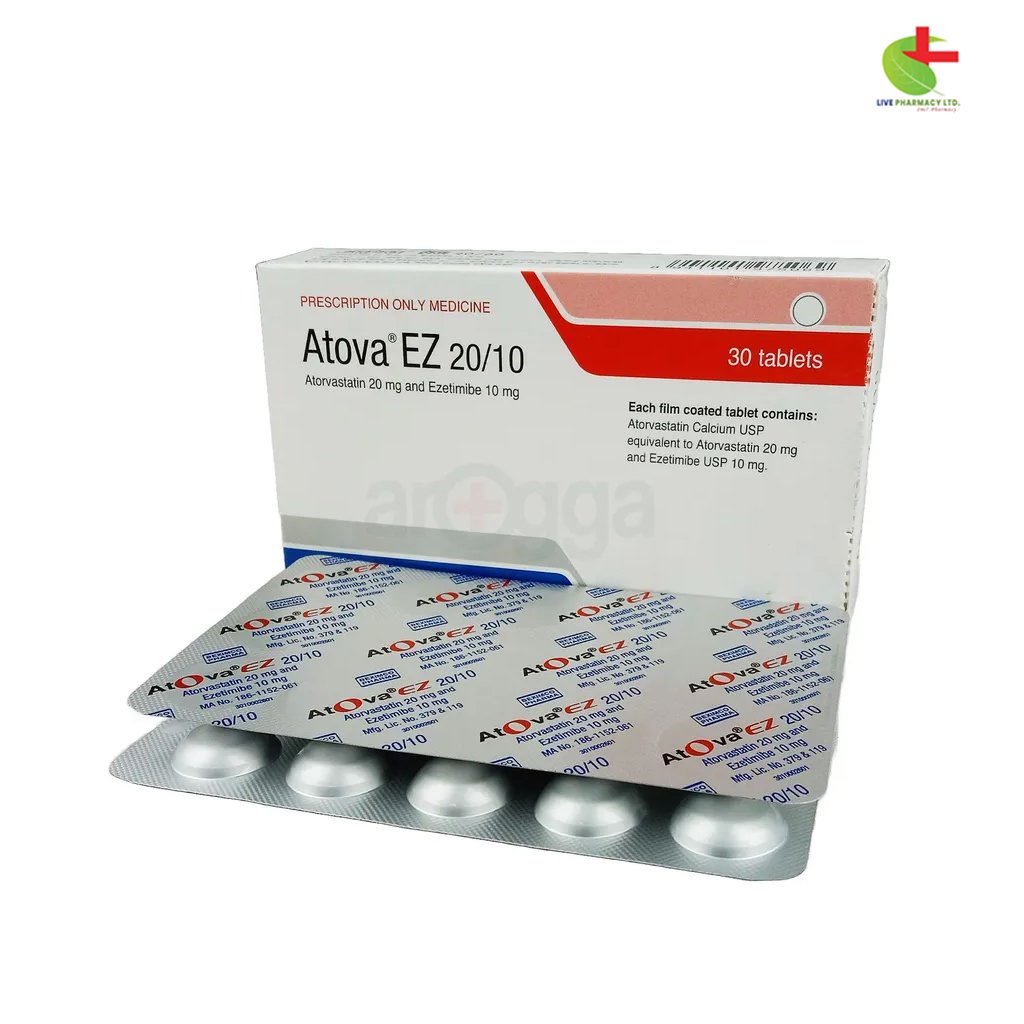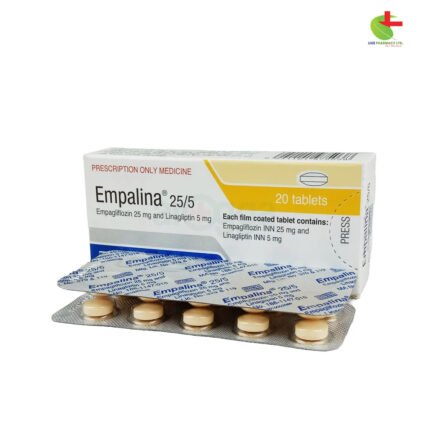Atova EZ 20/10
330.00৳ Strip
- Atova EZ is used to manage high cholesterol and reduce cardiovascular risk.
- It lowers elevated levels of total cholesterol, LDL-C, and triglycerides, and increases HDL-C.
- Suitable for patients with primary hyperlipidemia and homozygous familial hypercholesterolemia.
- Combines two mechanisms: inhibiting liver cholesterol synthesis and blocking intestinal cholesterol absorption.
 Brand
Brand
|
Beximco Pharmaceuticals Ltd |
|---|---|
 Generics
Generics
|
Atorvastatin + Ezetimibe |
 Type
Type
|
Tablet |
Indications for Use
Lipid-altering therapies should be part of a comprehensive approach to managing individuals at high risk of atherosclerotic vascular disease due to hypercholesterolemia. Medication is recommended as an adjunct to dietary modifications and lifestyle changes when these measures alone do not sufficiently lower cholesterol levels.
Primary Hyperlipidemia: This medication is designed to lower elevated levels of total cholesterol (total-C), low-density lipoprotein cholesterol (LDL-C), apolipoprotein B (Apo B), triglycerides (TG), and non-high-density lipoprotein cholesterol (non-HDL-C), while increasing high-density lipoprotein cholesterol (HDL-C) in patients with primary hyperlipidemia, whether familial or non-familial, as well as those with mixed hyperlipidemia.
Homozygous Familial Hypercholesterolemia (HoFH): This medication is also indicated for reducing elevated total-C and LDL-C in patients with homozygous familial hypercholesterolemia. It should be used alongside other lipid-lowering treatments, such as LDL apheresis, or when such treatments are not available.
Pharmacology
Atorvastatin: Atorvastatin lowers cholesterol and lipoprotein levels by inhibiting HMG-CoA reductase, reducing cholesterol synthesis in the liver, and increasing hepatic LDL receptors. This results in enhanced LDL uptake and breakdown, decreased LDL production, and fewer LDL particles.
Ezetimibe: Ezetimibe works by blocking cholesterol absorption in the small intestine through its action on the Niemann-Pick C1-Like 1 (NPC1L1) transporter. Clinical studies show that ezetimibe can reduce intestinal cholesterol absorption by 54%, with no significant impact on fat-soluble vitamin levels or adrenocortical hormone production. Ezetimibe complements statins by lowering hepatic cholesterol levels and increasing blood cholesterol clearance.
Dosage & Administration
The dosage range is between 10/10 mg and 80/20 mg daily, starting with 10/10 mg or 20/10 mg daily. The dose can be taken once daily, with or without food. For patients needing a substantial reduction in LDL-C (over 55%), the recommended starting dose is 40/10 mg daily. Lipid levels should be checked within 2 or more weeks after starting or adjusting the dosage.
For Homozygous Familial Hypercholesterolemia: The recommended dosage is 40/10 mg or 80/10 mg daily, used in conjunction with other lipid-lowering treatments or if such treatments are not available.
Patients with Hepatic Impairment: This medication is contraindicated for those with active liver disease or unexplained persistent elevations in hepatic transaminases.
Patients with Renal Impairment: Individuals with renal impairment may be at higher risk for statin-associated myopathy and should be monitored closely. No dosage adjustment is required for these patients.
Interactions
The risk of myopathy increases when this medication is used with fibric acid derivatives, high doses of niacin, cyclosporine, or strong CYP3A4 inhibitors (e.g., clarithromycin, HIV protease inhibitors, itraconazole). Avoid combining Atova EZ with cyclosporine and gemfibrozil. Exercise caution when using Atova EZ with niacin or colchicine. Monitor patients taking digoxin and consider the increased AUC values for norethindrone and ethinyl estradiol when selecting an oral contraceptive. If Atova EZ is added to warfarin, monitor the International Normalized Ratio (INR) appropriately.
Contraindications
Do not use this medication in individuals with active liver disease, unexplained persistent elevations of hepatic transaminases, or hypersensitivity to any component of the formulation.
Side Effects
Common side effects include rhabdomyolysis, myopathy, liver enzyme abnormalities, myalgia, abdominal pain, and increased hepatic enzymes.
Pregnancy & Lactation
Pregnancy Category X. This medication is contraindicated for pregnant women or those who may become pregnant, as lipid-lowering drugs are not beneficial during pregnancy and cholesterol is essential for fetal development. The presence of atorvastatin in breast milk is unknown, but caution is advised.
Precautions & Warnings
Monitor for myopathy, including rhabdomyolysis, especially when coadministered with colchicine. Discontinue therapy if serious myopathy or conditions leading to renal failure occur. Regular liver enzyme tests are recommended before and during treatment, and therapy should be interrupted if serious liver injury occurs. Exercise caution when using Atova EZ with drugs that may affect endogenous steroid hormone levels.
Use in Special Populations
Pediatric Use: Safety and efficacy in children have not been established.
Geriatric Use: No dosage adjustment is required for elderly patients.
Overdose Effects
In case of overdose, provide symptomatic treatment and supportive care as needed. There is no specific treatment for overdosage.
Therapeutic Class
Other lipid-regulating drugs.
Storage Conditions
Store below 30°C, in a dry place, away from light, and out of reach of children.













Reviews
There are no reviews yet.